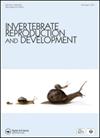Fecundity and reproductive patterns of the fiddler crab Uca maracoani Latreille 1802-1803 in an Amazonian estuary in northern Brazil
IF 0.8
4区 生物学
Q4 REPRODUCTIVE BIOLOGY
引用次数: 1
Abstract
ABSTRACT In this study, aspects of the reproductive biology of a Uca maracoani population from northern Brazil were examined. Ovigerous females monthly captured from December 2013 to November 2015 were measured and dissected to count, collect morphometric data, and classify the eggs. Ovigerous females were encountered throughout the two-year period but were absent during the months with the highest rainfall and lowest salinity, which indicates a seasonal–continuous reproductive pattern. The fecundity varied from of 12,233 to 85,000 eggs per female, and mean was 36,840 ± 3,361 eggs. The egg size increased progressively and significantly over the course of embryonic development. We found a direct relationship between the size of the females and their fecundity, and a clear trend was seen in which the larger females produced more eggs with larger sizes, which increased less in size during embryonic development. The presence of early- and late-stage eggs together in the same ovigerous mass in a considerable number of the ovigerous females suggests multiple spawning. The fecundity of U. maracoani is greater than that of other Atlantic fiddler crab species, and its reproductive strategy ensures its survival in the estuaries of the Amazon coast, which are subject to considerable fluctuations in salinity.巴西北部亚马逊河河口招潮蟹Uca maracoani Latreille 1802-1803的繁殖力和繁殖模式
摘要在这项研究中,对来自巴西北部的乌卡马拉科尼种群的生殖生物学方面进行了研究。对2013年12月至2015年11月每月捕获的产卵雌性进行测量和解剖,以计数、收集形态计量数据并对卵子进行分类。在整个两年期间都会遇到产卵的雌性,但在降雨量最高、盐度最低的月份却没有出现,这表明了季节性的持续繁殖模式。每雌产卵量为12233至85000枚,平均为36840±3361枚。卵子大小在胚胎发育过程中逐渐显著增加。我们发现雌性的大小与其繁殖力之间存在直接关系,并且可以看到一个明显的趋势,即体型较大的雌性产下的卵子越多,体积越大,而在胚胎发育过程中,卵子的体积增加得越少。在相当数量的产卵雌性中,早期和晚期卵一起出现在同一产卵群中,这表明它们有多次产卵。马拉科尼乌鱼的繁殖力高于其他大西洋招潮蟹物种,其繁殖策略确保了其在亚马逊海岸河口的生存,这些河口的盐度波动很大。
本文章由计算机程序翻译,如有差异,请以英文原文为准。
求助全文
约1分钟内获得全文
求助全文
来源期刊
CiteScore
1.90
自引率
0.00%
发文量
21
审稿时长
>12 weeks
期刊介绍:
Invertebrate Reproduction & Development ( IRD) presents original research on the reproductive and developmental biology of the Invertebrata, both embryonic and postembryonic. IRD welcomes papers reporting significant results obtained using new techniques. Encouraged topic areas include: aquaculture, physiology, biochemistry, functional morphology, phylogeny, behavioural and regulatory mechanisms, including genetic, endocrine and molecular studies. Papers containing qualitative descriptions of reproductive cycles and gametogenesis will not be considered. IRD is published in association with the International Society of Invertebrate Reproduction and Development.

 求助内容:
求助内容: 应助结果提醒方式:
应助结果提醒方式:


